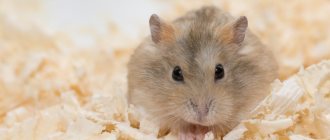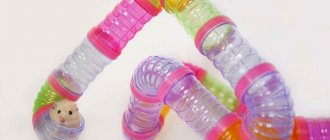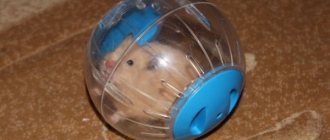How to handle a hamster?
Gaining your hamster's trust will take patience and some time. However, all the efforts spent on this will pay off in full - communication with your pet will bring you only joy. What are the do's and don'ts when handling hamsters?
It is forbidden:
- make sudden movements or wave your arms near the hamster;
- pick up a hamster that has just woken up or is sleeping;
- drive into a corner or cover with palms;
- scream loudly near the cage;
- leave it on high surfaces - it does not distinguish distances and will definitely fall down;
- grab by the scruff of the neck with a rough movement.
Can:
- talk to the animal in a soft, calm voice;
- when picking him up, do it slowly and carefully, clasping him under the front paws;
- touch the hamster only with clean hands and give him the opportunity to sniff your hand first - this way he will quickly get used to your smell;
- Give him a chance to calm down if he is scared.
Expanding space and horizons outside the cage
Is it possible to walk a hamster?
The rodent is walked in the house or on the street. At home, the hamster explores its owner and unfamiliar places. A walking ball will provide additional benefits for physical health. To prevent the pet from running away, a person should set up restrictions. For example, build a rectangle out of cardboard.
Walking outside
The rodent will happily explore the lawn, flower garden, and courtyard of a private house. The hamster needs to be allowed to run around and stretch its legs. But such walks often result in the pet running away from the territory. Here are some tips to help you properly organize your hamster walk:
- Monitor your surroundings carefully. The furry pet should not be attacked by dangerous predators - raven, rat, cat, dog, tit;
- remove dangerous objects containing toxic substances and heavy metals from the walking area;
- remove painted wood products from the lawn;
- Decorative and simple flowers should not grow nearby;
- use a leash or walking ball. The first option is more attractive: the hamster freely explores the world far outside the cage.
Walking balls for rodents
An additional device for increasing the activity of your pet is a walking ball for rodents - hamsters and chinchillas. Ensures safe movement around the apartment - the animal will not hide behind furniture, chew property, be eaten by a cat, or be accidentally crushed.
Recommended models:
- For walks around the house - do not allow the pet to get out on its own. IMAC Fun Bowl models are designed in the shape of a rugby ball, which prevents them from tipping over on their side. IPTS Beeztees and Triol - round design. The balls are easily opened by the owner of the animal and are equipped with holes for ventilation.
- For a cage, the animal can independently enter and leave the ball. Model IPTS Beeztees with entry holes is a walking ball for a hamster, used in a cage or apartment under strict supervision. Transparent material allows you to observe your pet.
You can buy a silent wheel and a walking ball for a hamster, chinchilla or rat at the price from the manufacturer in the 12 Monkeys store. There is a wide selection of models of different diameters. We sell high-quality and safe products from leading manufacturers.
What to do if your hamster runs away?
First and foremost, isolate other pets that could cause harm to the fugitive. Next, remove, if any, all dangerous and poisonous objects that a rodent can get. (for example, sharp objects on the floor, poison from cockroaches, etc.)
Where to look for a hamster?
Don't worry and remember that hamsters are very curious and love to explore everything carefully. If you immediately notice the animal is missing, it means that it is somewhere nearby exploring new places.
You should inspect the apartment in the following order:
- surroundings of the cell;
- places near pieces of furniture (places under the sofa, behind the closet, under the table, etc.);
- directly pieces of furniture (in the closet, in the desk drawer, in the laundry basket and in other containers);
How to lure out a fugitive?
It is not always easy to find a hamster by inspection - there may be too many objects in the apartment, or you do not have access to cracks and openings (for example, due to immovable furniture). In this case, it’s easier to lure the hamster out using a trick: pour his food in a visible place, put his favorite toy, call your pet affectionately, and other methods described below.
How to catch a hamster?
If you find your pet, don’t immediately run to it with open arms. The hamster does not feel comfortable outside the cage, so any sudden movement will be an additional signal of danger for him.
If your baby is too active or timid, you can throw a waffle towel over him. In this case, the rodent's movements will be limited, and you can easily catch it.
Methods for catching a hamster
What kind of rodents run in a wheel?
Runners for rodents are used if the animal is kept in a cage that does not allow it to move a lot and quickly. Lack of activity causes obesity, muscle weakness, chronic diseases, and shortens life expectancy.
Wheels and balls for rodents allow you to reproduce natural habitat conditions. The animal instinctively understands what the device is intended for and how it is used. Often, it is enough for the owner to help the pet once.
They are used when keeping fast-moving animals - rats, hamsters, mice, and less often chinchillas. The rabbit wheel is not used - this animal does not run, but jumps.
Types of hamsters that can be kept at home
Of the variety of hamsters, only a few species are kept at home.
Below are the most common domestic hamsters and their photos.
Pre-Asian hamster
The most popular species for keeping at home is the Central Asian or Syrian hamster (Mesocricetus auratus). Very little is known about its life in the wild. In 1839, the first representative of this species was described, found in the Syrian desert. For a long time it was believed that the pre-Asian hamster was extinct, but in 1930 a female and her litter were captured in Syria and then taken to Israel. A single family in captivity quickly multiplied, and the species was introduced to pet owners in the 1940s.
Today the Syrian hamster is one of the most popular pets.
He is quite unpretentious, has a calm character, and what is very important, rarely gets sick
The body length of the Syrian hamster does not exceed 14 cm, and its weight is 250 grams. The animal's tail is so short that it is practically invisible due to its fur. Its natural color is golden, although breeders have developed a large number of color variations: if desired, it is not difficult to find white, beige, gray and even black animals. In addition to the solid-colored varieties, patterned types have been developed: tortoiseshell (with large white, yellow spots, and tricolor), with a white belt around the body, and spotted. Eyes may be black, red or pink.
However, breeders went further and bred animals with three other types of coat, each of which can have different colors.
In the photo below, the so-called “Angora” hamster is essentially the same Syrian, only long-haired.
The Syrian hamster, with its thick, tousled, wavy fur and curly mustache, is called the royal hamster.
With the satin type, the coat is short, smooth, and surprisingly shiny.
Djungarian hamster
Another popular species for home keeping is the Djungarian hamster (Phodopus sungorus). It is smaller in size than the Syrian (its body length is 7-10 cm), but is even more active at night.
The external feature of this species is a narrow black stripe running along the animal’s spine. Its coat is not very long, with white patches.
Roborovsky's hamsters
This dwarf species has a body length of no more than 5 cm, the tail is hidden in a thick fur coat. The fur of the Roborovskiy hamster (Phodopus roborovskii) is golden sandy in color; A characteristic feature is the white brow ridges in the form of a mask. In nature, they live in Mongolia and Northern China.
They are great pets to watch, however, they are not as friendly as Syrians and are more difficult to communicate with. They are very nimble, can make amazing jumps, but are not able to sit on their hands for even a second.
And if it is better to keep Syrian and Djungarian hamsters one at a time, since in a confined space they will fight among themselves, then Roborovsky hamsters can be kept in pairs and groups - they are not aggressive towards their relatives.
Campbell's hamster
These hamsters are similar in appearance to Djungarian hamsters, differing from them in a thinner and more diffuse stripe on the back. In addition, Campbells (Phodopus campbelli) can be spotted, and their fur is not smooth, but in tufts.
In nature, they are found in Kazakhstan, Mongolia, and northern China. In Russia they inhabit Transbaikalia, Buryatia and Tuva.
Thanks to breeders, domestic Campbells can have a variety of colors; in nature, the color of their fur coat is dark gray with a brownish tint.
Rules for feeding Syrian hamsters
The owner of a hamster must know what to feed his pet and how to do it correctly. To do this you need to have an idea about their lifestyle.
Diet
Hamsters are animals whose greatest activity occurs in the evening. Be sure to take this into account when creating a menu for your pet. It is better to divide the entire daily diet into two parts: it is recommended to give the smaller part in the morning, and the larger part in the evening.
As for drinking, the hamster should always have clean water at room temperature freely available. For this, it is better to purchase a special drinking bowl. It is not recommended to place a bowl of water in the cage - an active animal will quickly knock it over. In addition, debris will constantly fall into it.
Vitamins for golden hamster
Pet stores sell special vitamin complexes for rodents. As a rule, they are available in liquid and solid form. Vitamins in liquid form can be added to the drinking bowl, and in solid form - in food. The first option is more convenient, but also more expensive.
You can put a mineral stone in the rodent's cage. It helps the hamster grind down its incisors, improves digestion and supplies the body with essential minerals. Hamsters usually gnaw on such stones with pleasure.
There are also chalk stones on sale that supply the body with calcium and other trace elements. They can be either regular or with various additives - herbal or fruit. Such stones are especially useful for pregnant females. Under no circumstances should you give your hamster regular school chalk - it is not food grade and can therefore be dangerous for the small rodent.
How to avoid digestive problems?
The hamster's diet should be balanced. If you buy ready-made food and mixtures, be sure to check the expiration date.
Hamsters love to hoard food, and rotten food can cause digestive problems. Therefore, from time to time it is recommended to check the hidden places of the cage and throw away any spoiled food.
Typically, adult and healthy hamsters do not suffer from indigestion. If your pet still has problems, try giving him boiled broken rice for diarrhea or a little vegetable oil for constipation. And be sure to review your hamster’s menu so that digestion returns to normal.
It’s good if the food has a protein component
Pros and cons of homemade toys for hamsters
Homemade toys for pets have a number of advantages:
- An opportunity to show care for an animal. The owner devotes his personal time to making a staircase, tunnel or labyrinth, doing his best for the hamster.
- Cheapness. Often homemade toys are cheaper than store-bought ones.
- Ability to control the quality of materials. The owner knows exactly what the product is made of and is confident that there are no toxic compounds.
There are also disadvantages. Homemade toys can be unsafe. You will have to carefully remove sharp elements that risk injuring the animal. The service life is often shorter than that of industrial products.
Signs of hamsters appearing in a summer cottage
Wild species of rodents are not afraid of humans. Fighting hamsters in the garden is a troublesome task. If there is a lot of food in your area, then the animal will live peacefully and often not in one copy.
At a time when his reserves are in danger, he can put up violent resistance and attack a person, protecting his bins.
Signs of a rodent appearing in a suburban area are:
- Presence of holes and tracks.
- Numerous passages and paths along which animals move.
- Digging for tubers.
- Damaged fruits or their remains after being eaten.
- The bark at the bottom of trees or bushes has been eaten.
A single effective method of exterminating wild hamsters has not yet been invented. Everyone chooses for themselves the most acceptable method from many existing ones.
How to equip a cage yourself
Home accessories
A rodent cage must have:
- house;
- running wheel;
- ladder;
- drinking bowls;
- feeder;
- toys.
All accessories for a hamster can be easily found at any pet store.
Educational toys for hamster
Hamsters are very energetic and therefore require additional ways to spend their time, namely rodent toys.
There are several types of toys. Some are suitable for grinding teeth, others can be climbed on and played hide and seek, and others can be chased around the entire cage, as if playing football.
The video shows an excellent example of a DIY hamster maze.
Drinking and eating facilities
For drinking water, it is better to use special drinking bowls that are attached to the wall of the cage. The saucer may not be stable and litter will fall into it.
Some feeders are also hung on the wall of the home, so that pets will not knock them over. If the breeder prefers a bowl that is not attached, then it is better to choose a ceramic one, it is more stable.
Toilet
Pet stores sell special toilet corners that are mounted in the corner of the cage. A corn filler is suitable for them, which does an excellent job of eliminating unpleasant odors.
Sand bath
Animals use sand to keep their fur and paws clean.
A sand bath is not a necessary item in the cage, but the rodent will be happy to have it.
You cannot use sand from the street. You can use this product for chinchillas, the main condition is the absence of talc.
Any container is suitable for this purpose; the filler layer should be 2-3 cm.
Hamster bedding
It is very important to use quality bedding. The hamster will dig in it and relieve itself
Most often, breeders use sawdust, which is poured in a layer of 6 cm.
Other DIY activities for hamsters
Various objects can occupy children's leisure time. Wooden toys from which paint and varnish have been removed will serve as objects for grinding teeth - rodents also need this. Wooden branches and blocks that you collect in the forest will also please hamsters. Fruit tree branches can be used if they have not been treated with chemicals.
Large pieces of pet-allowed fruits and vegetables in the cage are sure to keep the little ones occupied. It is necessary to remove these fruits in the evening, otherwise they will begin to spoil.
The most ordinary objects that are in every home can become toys. A toilet paper roll and a small flower pot are toys for Djungarian hamsters; for larger relatives, a set of children's plastic or wooden cubes and larger flower pots are suitable.
Ropes, ladders, bridges, slides
Rodents love to climb; they hold on well to ropes and crossbars. Unfortunately, it is difficult for them to go down - they fall and can injure their paws. The task of the rodent owner is to make the entertainment as safe as possible. If you want to make a toy for a hamster with your own hands, consider the height of the structure. The homemade rope should be attached low, the stairs should be flat, and the slides should be safe.
Video: how to make a slide for a hamster with your own hands
A ceramic pot can be used as a slide.
It is very easy to make a ladder from cardboard. Cut out 2 rectangles of the same width. One will serve as the base of the ladder, from the other you need to make steps. Take the second rectangle and cut it crosswise into narrow, identical strips. Glue these strips onto the first rectangle at small intervals. Attach the ladder to the house or shelf.
A convenient bridge can be made from ice cream sticks. Prepare about 30 sticks, PVA glue, a large bowl, clothespins. The procedure is as follows:
Video: how to make a bridge for a hamster with your own hands
How to make a house with your own hands?
Making your own house for a pet helps to unite the family. The most common materials for construction:
Coconut shell. Dwarf hamsters will appreciate your efforts when they receive an original coconut shell house for use. The Dzungarians will be happy to hide in it and relax.
Plastic cage for hamster
Rules for peeling the insides of a nut:
- open the eyes of the coconut and drain the milk through them;
- tap next to the eyes with the blunt side of a knife or a chop mallet and when a crack appears, remove part of the shell using a knife or hacksaw;
- place the fruit in the freezer for half an hour, which will make it easier to separate the pulp;
- remove sharp corners and burrs, sand the edges of the hole.
- Lego. An unnecessary children's construction set will serve as a wonderful building material for a pet's home. The number and type of Lego parts will determine whether you will have to limit yourself to a modest house or whether you will be able to build a real castle. It may be possible to build a fence, fence off a playground and build a staircase.
Important! Gluing joints will help achieve maximum strength.
- Cardboard box. Miniature animals will willingly use houses that are made for them from used packaging. Even a small owner can cut out an entrance in a cardboard container. Ventilation holes are also welcome. If you have a tissue box with a ready-made hole, just cut it into two halves. You can use a toilet paper roll at the entrance as a corridor. The disadvantage of a cardboard house is its fragility.
- Parcel box. It is not particularly durable, but such containers can only be slightly modified, and plywood can be easily adjusted. All you need to do is drill an entrance on the side of the box, windows and paint the house - if desired.
Important! You can paint an animal’s home only with non-toxic paints: watercolor or gouache
- Stand for toothbrushes. The oval object is laid on its side and fixed. Other available materials can also serve as suitable materials for equipping a dwarf hamster’s house: bowls, basins, jars for bulk products, food containers, plastic bottles, flower pots.
- Plastic containers for cereals. It happens that a hole in cans of this type is already provided. If the lid is solid, you can simply cut it in half to provide your pet with passage inside. The round jar should be secured.
- Glass jar. Durable and easy to clean dishes that are sure to please owners. But not all pets are optimistic about transparent shelters, preferring to hide in a secluded place. The situation is corrected by painting or gluing the jar, which then must be attached to the walls of the cage with wire. Before pouring the bedding, the slippery surface of the bottom is smeared with glue and sprinkled with sand.
- Branches. Suitable for creating a kind of cave. The cardboard strip is glued to the floor with short sides like an arched roof, which is glued on top with pieces of thick branches and blocks. The back wall can be made of cardboard or sewn up with branches. The second option: the base of the house is made of a ready-made box or a home-made frame, which is then covered with twigs on top.
- Popsicle sticks. This idea of building a hut for everyone’s favorite will be more useful to city dwellers, since in city conditions it is difficult to collect a sufficient number of even branches. First, each detail of the house is drawn on cardboard and cut out with scissors. Then, the elements of the hut are fixed to each other using tape and the blank is glued on the outside with ice cream sticks.
- Wooden boards and plywood. Using the previous sketch, you can build a wooden house with a flat or gable roof. This time, the parts are cut out of a board or sheet of plywood and attached to a frame made of wooden blocks with nails or self-tapping screws. If the roof is removable, this will greatly facilitate the cleaning process.
Running wheel designs
Manufacturers offer many types of running wheels, differing in design, mounting method, and material. Let's talk about the main varieties.
Stairs
Their running surface consists of crossbars. It is convenient for the rodent to push off, grabbing the crossbar not only with its claws, but also with its fingers. Disadvantage: the foot may fall into the gap, which can lead to injury. Careful selection of wheel size allows you to avoid injury.
For babies and dwarf breeds of hamsters, a diameter of 9-16 cm is recommended - models Darell, Inter Zoo, Triol, IPTS. The distance between the crossbars is carefully calculated - the likelihood of injury is minimized.
The Green Farm model hamster wheel on a stand is made of wood - a safer option and an excellent design solution. Suitable for adult dzhungarik, white mice, cubs of dwarf breeds - diameter 16 cm.
Mesh
Its surface is made of metal mesh. Injuries are completely eliminated. The Inter Zoo running wheel offers two installation options – on a stand or fixed to the cage wall. The Darell brand line includes diameters up to 35 cm - a large rodent wheel suitable for chinchillas and rats.
Solid plastic
Solid surface with relief for ease of repulsion. Models Triol WL05 and silent hamster wheel IPTS are equipped with sides that prevent the pet from falling out when running. The Triol Sputnik wheel has a parabolic shape - it is safe and designed for the smallest animals.
When choosing a model, pay attention to the installation method:
- Stand – installed on the floor, suitable for spacious cages.
- Wall mount – fixed on the cage lattice, allowing you to maintain space for the animal to move. If the kit does not include a fastening device, you can use improvised means - strong wire, cord.
For owners who have not decided on the choice of installation method, we recommend a universal model - Inter Zoo metal hamster stair wheels, the stand of which is equipped with hooks for hanging. The hamster wheel on the stand must be stable - we recommend additionally securing the device to the wall with a rope.
Ideas on how to make a comfortable house for a hamster - diagrams, drawings and instructions
From plastic bottles
Option 1. To make a shelter for an animal from plastic bottles, you need 2 clean bottles of 1-1.5 liters, electrical tape, scissors and a stationery knife.
The neck and bottom of both containers are cut off, and the cut points are treated with electrical tape to prevent the occupant from being injured in the future. A hole is cut in one of the bottles exactly in the middle, equal to the diameter of the second.
The second container is inserted into the finished cutout of the first container; it should fit tightly. The resulting structure is secured with electrical tape.
Option 2. Such a house can replace a cage and will be like an aquarium with several compartments.
Several clean bottles with a volume of 5 or more liters are required. Each of the containers will represent a so-called room, so the number of containers used is limited only by the imagination of the master. You will also need a utility knife and scissors.
- The tops of the bottles are cut off. The height of future rooms should be such that the pet cannot climb over it and get lost in the bowels of the apartment.
- The necks are cut off from the remaining upper part of the bottles so that they look like funnels. You won't need caps for them.
- In the lower part of the container, almost at the very bottom, holes are cut, equal in diameter to the necks.
- All rooms are connected to each other through funnel necks.
In the video you can see what such an apartment looks like.
Does your pet live in a house made of natural materials? Poll Options are limited because JavaScript is disabled in your browser.
From cardboard
For construction you will need the most ordinary boxes of ready-made breakfasts or juice, scissors and a stationery knife.
All you have to do is cut the box to size and cut out the entrance.
If you use toilet paper rolls or paper napkins for construction, you will get an excellent labyrinth that rodents love so much. But you should take into account the size of the hamsters; for large individuals this type of entertainment is unacceptable.
From a box of paper napkins
For a simple construction, you will need one cardboard tissue box, stationery glue and a toilet paper or paper napkin roll.
It is necessary to remove all plastic elements and film from the future home. It is better to give preference to square-shaped containers; they can be cut exactly in the middle and you will get two ready-made houses that already have an entrance for the animal.
A toilet paper roll makes a great addition to your shelter. It is enough to glue it into the passage and it will be an imitation of a mink, which will obviously please the rodent.
From a plastic container
This type of container can be found in almost any home or purchased for a small amount in a store.
For construction you will need a food grade plastic container and a soldering iron.
- Using a heated soldering iron, the entrance to the house is cut out, and holes are made on the lid of the container for ventilation. This will help the pet feel comfortable in the home.
- Sawdust or any other bedding is laid out at the bottom of the house.
The advantage of such a structure is that it is convenient to wash, and it will also last longer than cardboard.
Wooden house
For construction you need:
- wooden board 1-4 cm thick;
- ruler;
- a simple pencil;
- circular saw or jigsaw;
- sandpaper;
- hammer;
- small nails.
Two parts 12.5 cm long and two parts 14.5 cm long are cut out and polished from the board. The height is taken arbitrarily, but it must be calculated so that the hamster can move freely.
A hole with a diameter of 6 cm is drilled (cut) in one of the 12.5 cm long blanks. Several small windows are made in different walls of the house for better ventilation. All cut holes are ground.
All parts are assembled using nails. You can use a square wooden sheet for the roof.
Mitten house
During the cold period, any living creature likes to bask where it is warm. Rodents are no exception.
During severe cold weather, it is enough to put a mitten that no one needs anymore in the cage. The hamster will instantly find a use for it and build his nest in it.
The downside of such a house is that it will most likely quickly acquire an unpleasant odor and wear out. Whether to replace it with a new one or not is up to the breeder to decide.
Coconut house
Due to its size, this type of housing is suitable only for Djungarian hamsters.
You will need:
- coconut;
- knife;
- hacksaw;
- sandpaper.
First, you need to drain the milk from the coconut by making holes in the eyes. Having stepped a couple of centimeters away from them, you need to tap with the handle of a knife; if a crack appears on the shell, then this part of the fruit is cut off with a knife, if not, then you should use a hacksaw. The pulp is completely cleaned. The cut edge is sanded with sandpaper.











